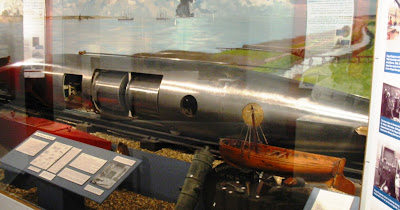In 1884 the War Office adopted the Brennan Torpedo for use as part the the United Kingdom’s harbour defences. Due to the nature of the torpedo’s unique propulsion and steering system*, special launching stations had to be built, and these were located at:
- Cliffe Fort on the Isle of Grain on the Kent side of the River Thames
- Fort Albert on the Isle of Wight
- Pier Cellars, Plymouth
- Fort Camden in Cork Harbour, Ireland
- Lei Yue Mun Fort in Hong Kong
- Forts Ricasoli and Tigné in Malta
Because of the weapon's relatively short range (it was 2,000 yard), it was decided to build a further launch station near Coalhouse Fort, which was located on the opposite side of the River Thames from Cliffe Fort. A site on the Mucking Flats was selected, and the contract for the construction of the launching station and a small coastal artillery fort that was designed to protect it, was awarded to Alfred Bean.
Alfred had been a partner in the construction firm of Bean and Jackson, who had built the breakwater for the projected military harbour at St Catherine's Bay in Jersey. He was also an advocate of the railways and besides being the driving force behind the Bexley Heath Railway Company, he had a narrow-gauge railway on his estate, Danson House, Welling Kent. When he surveyed the site of the launch station and coastal defence fort, he decided that because the roads across the Flats were incapable of carrying the necessary building materials, that a light railway would need to be constructed.
At first the War Office was very reluctant to sanction this, but when Bean pointed out that the locomotives and rolling stock could be ‘borrowed’ from Woolwich Arsenal and that they had a supply of suitable track in store as a result of the projected Suakin-Berber Railway, they acquiesced… and the Mucking Flats & Fobbing Marsh Light Railway was born.
* The Brennan Torpedo was a wire-guided AND wire-powered weapon. Inside the torpedo were two steel drums mounted one behind the other, each of which carried several thousands of yards of high-tensile steel wire. The drums were connected via a differential gear system to twin contra-rotating propellers. Each wire was attached to a steam-powered winch that was inside the launching station so that the torpedo could be steered by speeding up or slowing down one or both winches.
The following photographs (which were taken twenty years ago) show an example of the Brennan Torpedo on display at the Royal Engineers Museum, Gillingham, Kent.



























.jpeg)









Bob, what an ingenious back story for your railway! And an excuse to have military personnel and equipment on the layout too - very clever.
ReplyDeleteThat Suakin-Berber line seems to have been a Victorian HS2...
Best wishes,
Arthur
Arthur1815 (Arthur),
DeleteCheers! Everything I’ve included is feasible and might have actually happened, which I think makes my imaginary history more believable.
All the best,
Bob
The Brennan torpedo is one of my favourite exhibits in the RE Museum, a fascinating piece of engineering.
ReplyDeleteNigel Drury,
DeleteWhat I find interesting is that the Brennan Torpedo was rejected by the Admiralty in favour of Whitehead’s design - which was in the long run a better design - but then adopted by the War Office (in other words, the Army), who paid more for the production licence than the Admiralty paid Whitehead for their production licence.
All the best,
Bob
I presume it was integrated with coastal mine defence which was under RE control until 1905 when the RN took over.
DeleteNigel Drury,
DeleteI had not though of that ... but I would have expected that it would.
All the best,
Bob
I think that why it may have been discontinued around 1905. It seems rather Heath Robinson now but was very advanced at the time.
DeleteNigel Drury,
DeleteIt’s interesting to note that many modern torpedoes are wire-guided. Perhaps the Brennan was a design that was - in part - ahead of its time.
All the best,
Bob
Love the background, especially the torpedo.
ReplyDeleteMark Cordone,
DeleteCheers! Although the story isn’t true, it is a feasible one.
The Brennan Torpedo was a hefty bit of kit whose range was only limited by the amount of wire it could carry.
All the best,
Bob